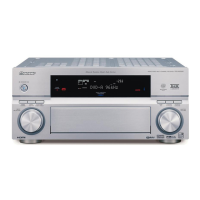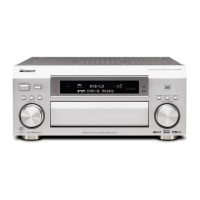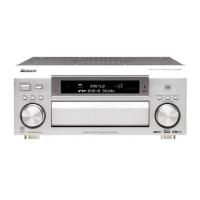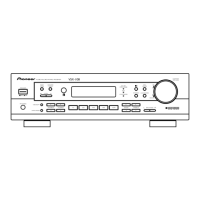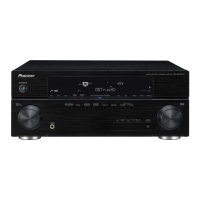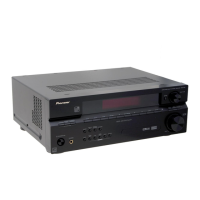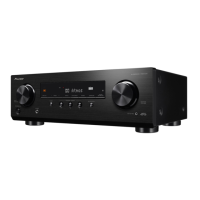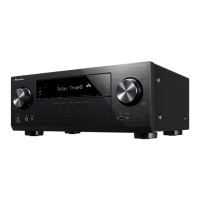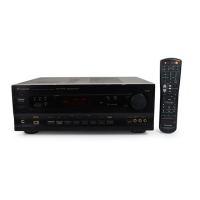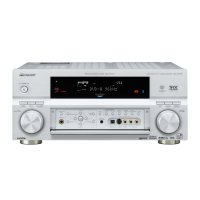
Do you have a question about the Pioneer VSX-AX4ASi-S and is the answer not in the manual?
| Channels | 7.1 |
|---|---|
| HDMI Inputs | 3 |
| HDMI Outputs | 1 |
| Component Video Inputs | 3 |
| Component Video Outputs | 1 |
| Speaker Outputs | 7 |
| DAC | 192kHz/24-Bit |
| Wi-Fi | No |
| Bluetooth | No |
| Digital Audio Inputs | 2 (Coaxial) |
| Digital Audio Outputs | 1 (Optical) |
| iPod Compatibility | Yes |
| Power Output | 170W per channel (6 Ohms) |
| Surround Sound Formats | Dolby Digital, Dolby Digital EX, DTS, DTS-ES, DTS Neo:6 |
| Frequency Response | 5Hz - 100kHz |
| Input Sensitivity | 200mV |
| Video Inputs | 4 (Composite) |
| Video Outputs | 2 (Composite) |
| Audio Inputs | 2 (Digital Coaxial) |
| Audio Outputs | 1 (Digital Optical) |
| Amplification Type | Discrete Direct Energy HD |
| THX Certified | Yes, THX Select2 Plus |
Covers electrical shock hazards, symbol meanings, and general cautions.
Details on moulded plug safety, fuse replacement, and operating environment.
Guidelines for safe power cord handling and using standby mode.
Ensuring proper ventilation and general product usage advice.
List of all supplied accessories included in the box.
Recommendations for proper receiver placement and location.
Instructions for battery installation and associated safety measures.
Basic explanation of home theater concepts and surround sound.
Steps for connecting speakers and performing initial setup.
Explanation of the automatic speaker calibration process.
Common issues and solutions for the automatic calibration.
Fundamental steps for playing audio and video sources.
Explanation and usage of the Phase Control feature.
Identification and description of all rear panel terminals.
Tips for proper cable connections to prevent hum and damage.
Explanation of the video conversion feature and its limitations.
Detailed guide for connecting a TV and DVD player.
Guide for connecting satellite/cable receivers.
Guide for connecting DVD/HDD recorders and VCRs.
Connection and benefits of component video.
Guide for connecting digital audio components.
Explanation of the WMA9 Pro decoder feature.
Connecting turntables, tape decks, and other analog audio devices.
Description of front panel audio/video connection jacks.
Guide for connecting speakers for surround sound.
Instructions for safe speaker wire connection.
Detailed steps for preparing and connecting bare speaker wire.
Advice for optimal speaker positioning for best sound.
Speaker placement recommendations for THX systems.
Instructions for connecting AM and FM antennas.
Final connection step and safety precautions.
Information on the switched AC outlet's capacity and usage.
Identification of front panel buttons, indicators, and display.
Further descriptions of specific front panel controls.
Information on the effective range and conditions for remote operation.
Meanings of the various indicators shown on the front panel display.
Identification and functions of the main remote control buttons.
Dedicated remote buttons for controlling TVs and components.
Operation of the secondary remote for multi-room control.
General notes on listening modes and receiver features.
Automatic sound selection based on source type.
Using surround sound modes and standard decoding.
Selecting and using THX modes for cinema-like sound.
Selecting and applying various surround sound effects.
How to select and use STEREO listening mode.
Switching between saved speaker calibration settings.
Activating modes for pure audio reproduction.
Selecting signal types: Digital, Analog, HDMI, i.LINK.
Configuring the use of surround back channels.
Simulating surround back channels without speakers.
Restoring sound quality to compressed audio.
Methods for finding FM/AM radio stations.
Entering specific station frequencies.
Storing and selecting favorite stations.
Using MPX for better FM reception.
Customizing names for saved radio stations.
Selecting stored radio stations.
Explanation of RDS features like station name and program type.
Finding stations based on program genre.
Viewing station data (RT, PS, PTY).
Automatic tuning for traffic and news broadcasts.
How to access and navigate the System Setup menu.
Detailed automatic speaker calibration procedure.
Configuration options for surround back speakers.
Introduction to manual speaker calibration adjustments.
Manually balancing speaker volume levels.
Setting speaker distances for accurate sound timing.
Reducing room resonance and 'boomy' bass frequencies.
Manually adjusting frequency response for optimal sound.
Advanced room EQ setup for detailed acoustic calibration.
Step-by-step guide for advanced EQ calibration.
Understanding the EQ graph analysis for room acoustics.
Customizing EQ based on specific room acoustics.
Connecting a PC for graphical EQ analysis.
Managing saved calibration settings: copy, rename, clear.
Viewing saved speaker calibration settings.
Transferring calibration settings between presets.
Customizing names for saved MCACC presets.
Removing unwanted saved calibration profiles.
Manual configuration of speaker parameters.
Setting speaker size, number, and crossover frequency.
Manually balancing speaker volume levels.
Adjusting speaker distances for accurate sound timing.
Limiting bass output to prevent distortion.
Adjusting tonal balance for movie soundtracks.
Specific settings for THX speaker systems.
Connecting and operating an iPod via the receiver.
Key controls for navigating and playing iPod content.
How to view media content directly from the iPod.
Guide for establishing HDMI connections for audio/video.
Explanation of the HDMI interface and its capabilities.
Connecting i.LINK (IEEE1394) enabled components.
Verifying i.LINK component assignments in the setup menu.
About Pioneer's Precision Quartz Lock System for audio.
How to connect multiple i.LINK devices in a chain.
Connecting analog audio for DVD-Audio/SACD sources.
Activating analog inputs for surround sound playback.
Connecting a computer via USB for audio playback.
Setting up a second audio zone.
Choosing between speaker systems A, B, or AB.
Advanced wiring for front speakers for improved performance.
Alternative speaker wiring method for improved sound.
Adding external amplifiers to power speakers.
Setting up independent audio systems in multiple rooms.
Source availability in different sub-rooms.
Initial setup for a primary second room audio zone.
Wiring guidance for multi-room audio setups.
Setup for a secondary third audio zone.
Operating sub-room functions via front panel controls.
Operating sub-rooms using the remote control.
Using an IR receiver for components in cabinets.
Automating component power control using 12V triggers.
Connecting to a Pioneer plasma display for enhanced features.
Features enabled by SR+ connection to plasma displays.
Connecting a PC for graphical MCACC results analysis.
Using PC software for MCACC analysis and visualization.
Assigning input sources to terminals and remote buttons.
Default assignments for input terminals and sources.
Accessing and configuring other system settings.
Setting volume levels for multi-room audio playback.
Configuring SR+ features for Pioneer plasma displays.
Adjusting the position of the on-screen display.
Adjusting various sound and picture settings.
Recording audio/video from tuner or connected sources.
Listening to a different source while recording.
Using input attenuator for strong analog signals.
Watching video from one source while listening to another.
Setting the receiver to turn off automatically.
Viewing current system configurations and MCACC status.
Adjusting the brightness of the front panel display.
Adjusting settings for 6 or 8 ohm speakers.
Restoring all receiver settings to their original defaults.
Listing of default values for various system settings.
Programming the remote to control external devices.
Choosing device codes from the remote's database.
Teaching the remote new commands via learning function.
Removing learned commands from the remote.
Clearing all programmed remote control settings.
Checking assigned preset codes for input sources.
Customizing input source labels displayed on the remote.
Controlling one component while using another.
Programming sequences of commands for multiple components.
Executing programmed multi-operation command sequences.
Shutting down multiple components simultaneously.
Using the remote control for TV functions.
Using the remote control for non-TV components.
Linking Pioneer components using the SR control system.
General advice and steps for troubleshooting.
Resolving issues with power on, shutoff, and button response.
Diagnosing and fixing problems with sound output.
Troubleshooting noise, odd sound, phase, and hum issues.
Resolving issues with picture display and recording.
Addressing errors or incorrect settings in MCACC.
Resolving issues with the EQ graph display.
Problems with the display being dark or indicators not lighting.
Resolving issues related to remote control operation.
Problems related to i.LINK connections and sound output.
Meanings of common i.LINK interface messages.
Resolving issues with USB audio playback.
Problems related to HDMI picture and sound connections.
Explanations for common iPod connection error messages.
Descriptions of main surround sound formats like Dolby and DTS.
Overview of THX technologies and their benefits.
Explanation of Re-Equalization, Timbre Matching, etc.
Criteria for THX Select2 certification.
Details on the THX Surround EX feature.
Explanation of ASA technology for speaker arrays.
Specific guidance on using the THX Select2 Cinema mode.
Using THX mode optimized for music playback.
Using THX mode optimized for game audio.
Chart detailing listening modes for stereo input signals.
Chart detailing listening modes for multichannel input signals.
Chart showing Stream Direct modes for stereo inputs.
Chart showing Stream Direct modes for multichannel inputs.
Power output specifications for stereo and multichannel modes.
Performance details for the FM tuner.
Performance details for the AM tuner.
Input/output levels, sensitivity, and frequency response.
Specifications for composite, S-Video, and component video.
Power requirements, dimensions, and weight.
List of all parts supplied with the unit.
Instructions for cleaning the receiver's exterior.
The company's dedication to home theater audio quality.
Summary of the receiver's major capabilities.
